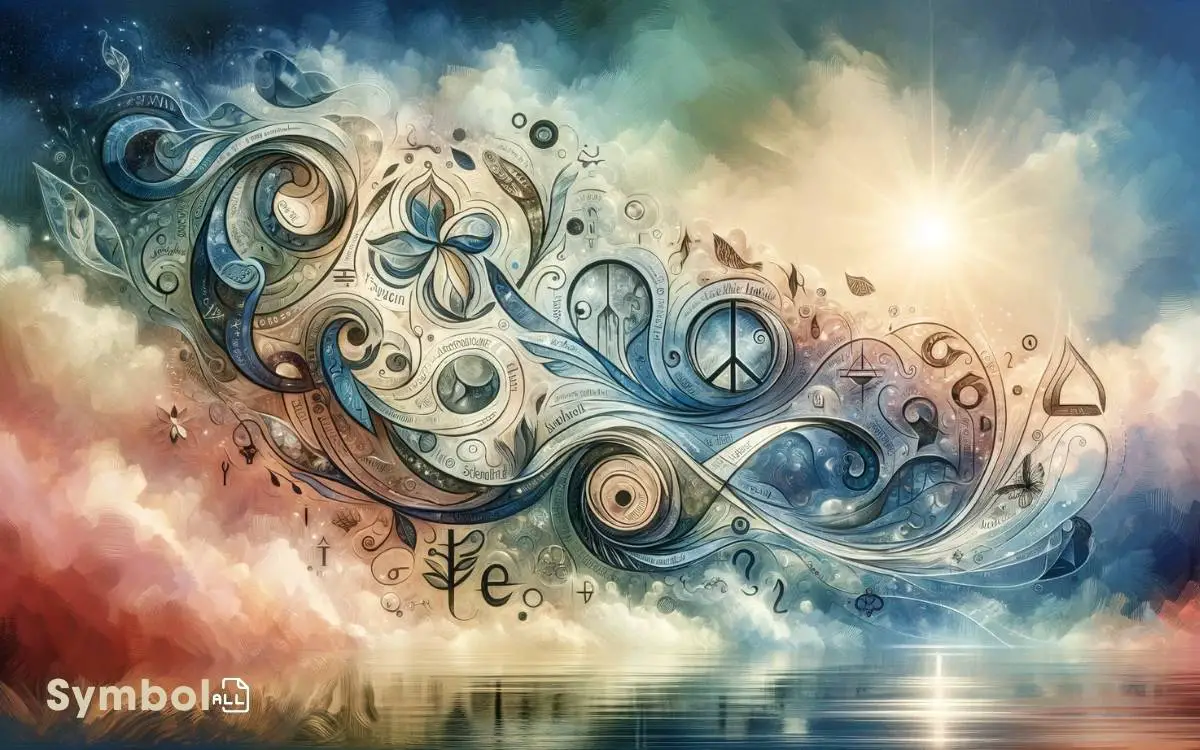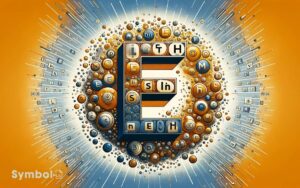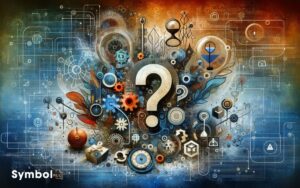Use Symbolize in a Sentence: Explains!
You often use “symbolize” to convey deeper meanings. For example, a red rose might symbolize love or passion in your writing. In everyday communication, you’re probably using symbols too think of how a heart emoji expresses affection.
Historically, symbols have depicted complex ideas, like the cross symbolizing faith in Christianity. In literature, authors use symbols to enrich stories, weaving in themes that transcend the surface narrative.
By understanding how to use “symbolize” effectively in a sentence, you unlock the ability to communicate layered messages.
This insight not only enhances your language use but invites you to explore beyond the obvious, discovering new depths in both your expression and interpretation.

Key Takeaways
Understanding “Symbolize”
To fully grasp its meaning, you should understand that ‘symbolize‘ refers to the action of representing something else, often an idea or quality, through a specific symbol or imagery.
This concept is crucial because it allows for the communication of complex ideas in a more accessible and often universal manner.
When you use ‘symbolize’ in a sentence, you’re not just describing a direct relationship between two things; you’re invoking a deeper level of interpretation and meaning.
For instance, saying ‘The dove symbolizes peace’ doesn’t merely equate the bird with the concept but suggests a rich tapestry of associations and emotions related to peace.
Understanding this enriches your comprehension and use of language, opening up a world where symbols convey the unspeakable or abstract in a tangible form.
Historical Contexts
Throughout history, symbols have played a pivotal role in shaping societies by encapsulating complex ideas and emotions that words alone can’t fully convey.
Here’s how:
- Ancient Civilizations: The Egyptians used hieroglyphs to represent concepts, deities, and natural elements, symbolizing their intricate belief systems and knowledge.
- Religious Icons: In Christianity, the cross symbolizes sacrifice and salvation, embodying deep spiritual significance and historical events.
- National Flags: Every stripe, color, and emblem within a flag tells a story of a nation’s heritage, values, and aspirations, uniting people under a common identity.
- Social Movements: Symbols like the peace sign or the rainbow flag convey collective desires for change, hope, and equality, rallying individuals around shared causes.
These examples show you’re surrounded by symbols that weave the narrative of human civilization, each carrying a multitude of meanings and histories.
Literary Examples
As you explore the realm of literature, you’ll find that symbols permeate both classic novels and modern texts, crafting layers of meaning that resonate deeply.
Through symbolic themes, authors convey complex ideas and emotions, inviting readers to interpret and connect with the narrative on a profound level.
In poetry, symbolic imagery enriches the text, transforming ordinary words into evocative, powerful experiences that linger long after the page is turned.
Symbolism in Classic Novels
In classic novels, authors often use symbols to convey deeper meanings, inviting you to delve beyond the surface narrative. These symbols enrich the story, adding layers of interpretation that you might miss on a first reading.
Here are a few prominent examples:
- The green light in ‘The Great Gatsby’ symbolizes Gatsby’s unattainable dreams and the American Dream’s promise and disillusionment.
- The white whale in ‘Moby-Dick’ represents the elusive nature of truth and the destructive obsession of Captain Ahab.
- The conch shell in ‘Lord of the Flies’ stands for law, order, and civilization amidst chaos.
- The scarlet letter in ‘The Scarlet Letter’ illustrates sin, guilt, and societal judgment but also evolves to represent strength and resilience.
These symbols invite you to look deeper, uncovering the rich tapestry of human experiences and emotions that classic novels encapsulate.
Modern Texts Symbolic Themes
Just like their predecessors, modern texts weave symbolic themes into their narratives, offering you a window into the complex interplay of human emotions and societal issues.
These stories don’t just entertain; they invite you to unravel layers of meaning hidden within, making you an active participant in the narrative.
For instance, dystopian novels often use desolate settings not merely as backdrops but as symbols of societal decay and the loss of individuality. Similarly, characters’ journeys can symbolize the search for identity in a fragmented world.
By engaging with these symbols, you’re not just reading a story; you’re peeling back the layers of contemporary life, uncovering truths about the world and perhaps even about yourself.
It’s a testament to the power of modern literature to mirror and critique the times we live in.
Poetrys Symbolic Imagery
Delving into poetry, you’ll find that its symbolic imagery serves as a bridge, connecting the palpable to the profound, and revealing layers of meaning that transcend the literal.
Through this lens, consider the following examples:
- The Raven in Poe’s work symbolizes mourning and unending grief.
- Spring often stands for rebirth or new beginnings in countless poems.
- Chains might represent oppression or the struggle for freedom.
- The Rose can denote love, beauty, or even the fleeting nature of life.
Each symbol enriches the poem, offering you a gateway to deeper understanding and connection. As you peel back these layers, you’ll grasp not just the poet’s message but also the universal truths that resonate within.
In Everyday Language
In your everyday conversations, you’ve likely used idioms or phrases that symbolize larger concepts without even realizing it.
From the heart symbol expressing love to the thumbs up emoji signaling approval, visual symbols and emojis carry weighty meanings in our digital communications.
Understanding these symbols can enrich your understanding and use of language in both personal and professional contexts.
Symbolism in Idioms
Everyday language brims with idioms that symbolize complex ideas or emotions through simple, vivid expressions. You mightn’t realize it, but you’re probably using these rich, symbolic expressions in daily conversations.
Let’s explore a few:
- Spill the beans – This idiom doesn’t involve actual beans. Instead, it symbolizes revealing a secret, painting a picture of accidentally tipping over a container and letting its contents scatter.
- Bite the bullet – Here, accepting something difficult or unpleasant is likened to a soldier biting a bullet during surgery without anesthesia.
- Break the ice – Imagine the initial awkwardness in a social setting as a thick layer of ice. This phrase symbolizes initiating conversation to melt away the tension.
- Walking on eggshells – This vividly describes the act of being extremely cautious to not upset someone or trigger a negative reaction.
These idioms enrich your language, offering a shortcut to express complex situations or emotions with clarity and brevity.
Visual Symbols Importance
Visual symbols play a crucial role in our daily communication, effortlessly conveying complex messages through simple, universally understood imagery. They bypass language barriers, allowing you to grasp a concept instantaneously. Whether it’s road signs, emojis, or app icons, these symbols streamline interactions by providing immediate clarity. In the digital age, texting images using symbols has become second nature, enabling people to express emotions, ideas, or instructions with just a few taps. This universal shorthand has revolutionized the way we connect, making communication faster and more inclusive than ever before.
Consider the red stop sign; its octagonal shape and bold color don’t just suggest, but command attention and action universally, without a single word.
You rely on such symbols daily, from identifying restrooms to understanding traffic signals, which guide and protect you. They’re not merely icons; they’re a language of their own, speaking volumes in a glance.
Recognizing and interpreting these symbols enriches your interaction with the world, making you more adept at navigating its complexities. Through visual symbols, you engage with a form of communication that’s both ancient and perpetually modern.
Emojis as Symbols
Emojis, the colorful symbols you often use in digital communication, have evolved into a modern language of their own, symbolizing emotions, objects, and ideas without the need for words.
When you send a message, you’re often choosing emojis that best express your feelings or thoughts, effectively transcending language barriers.
Here’s how they serve as powerful communicators:
- A heart emoji symbolizes love, affection, or solidarity.
- A thumbs-up represents approval, agreement, or satisfaction.
- A face with tears of joy conveys amusement, joy, or relief.
- A red angry face communicates frustration, anger, or annoyance.
Through these visual symbols, you’re able to convey complex emotions and messages succinctly, making your digital communication more expressive and nuanced.
Symbolize in Academic Writing
In academic writing, employing the term ‘symbolize‘ allows you to precisely convey complex ideas through the strategic use of symbols. It’s not just about using fancy words; it’s about elevating your argument or analysis to a nuanced level.
When you say a concept or object symbolizes something, you’re diving deep into its implications, exploring its layers of meaning beyond the obvious. This approach enriches your paper, offering your readers a lens through which they can understand your topic in a more sophisticated light.
It’s crucial, however, to ensure that the symbols you refer to are universally recognized or clearly defined within your work. This clarity prevents misinterpretation and strengthens your argument, making your academic writing not only insightful but also accessible.
Creative Exercises
After exploring how ‘symbolize’ can deepen your academic writing, let’s now turn our attention to how creative exercises can further enhance your understanding and use of symbolism.
These activities aren’t just fun; they’re crucial in honing your ability to convey complex ideas through symbols.
Here’s how you can start:
- Craft a Short Story – Incorporate symbols to represent key themes or characters.
- Poetry Writing – Use symbolism to add depth and layers to your poems.
- Visual Arts – Create artworks where objects or colors symbolize emotions or concepts.
- Journaling – Reflect on your day and identify moments or items that symbolized something deeper.
Conclusion
As you’ve journeyed through the realm of symbolism, you’ve learned its power to weave complexity into the fabric of language. Like a lighthouse guiding ships in the night, symbols illuminate ideas, transcending the mundane to touch the profound.
Whether etching depth into literary masterpieces, enriching academic discourse, or adding nuance to everyday conversations, you now grasp how symbols craft bridges between the seen and the unseen. Embrace this tool, and let your words paint worlds beyond the horizon.






